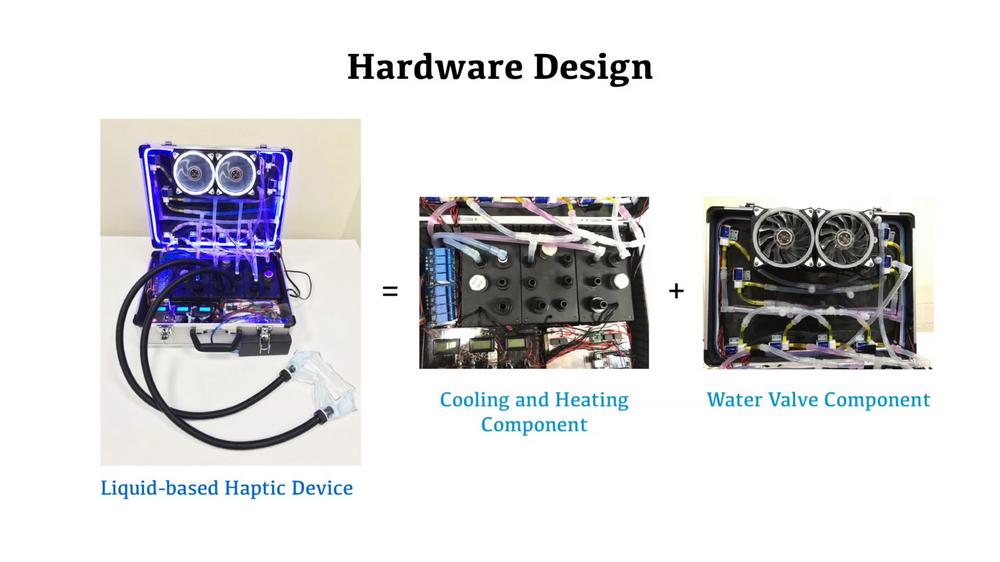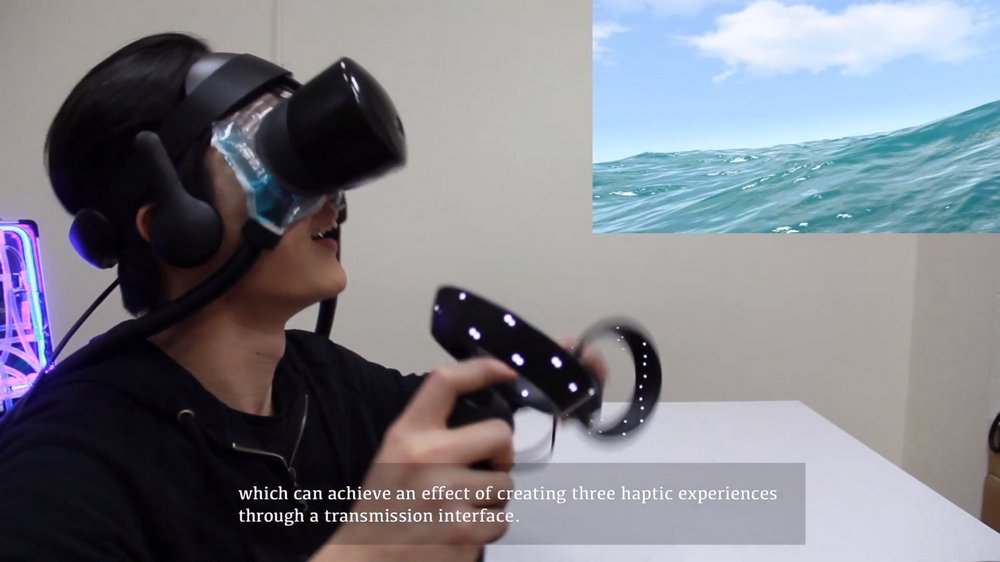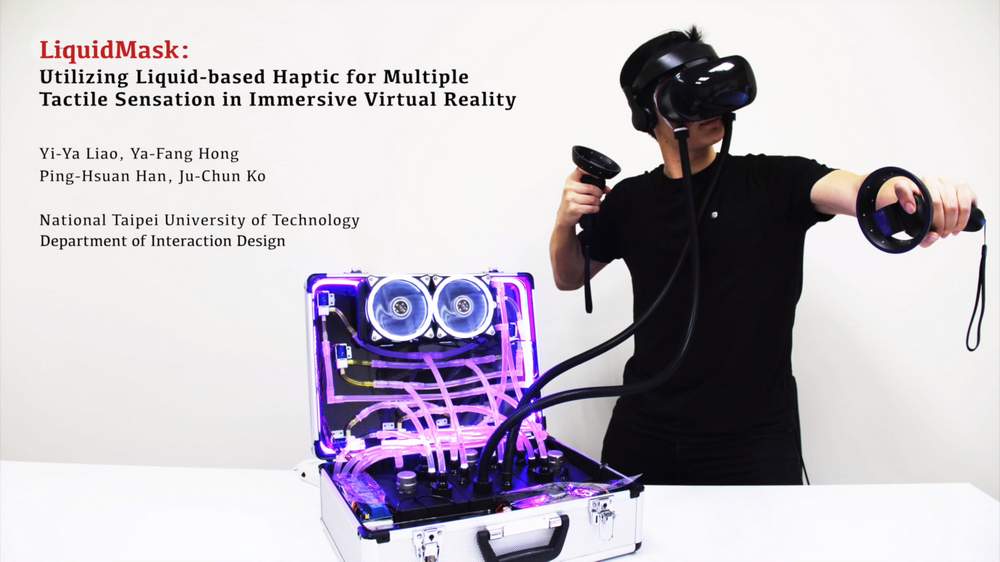LiquidMask VR: A New VR Face Mask Makes You Feel Like You Are Underwater
Taiwan-based researchers have developed a new water mask that can be worn under virtual reality headsets and which is capable of transmitting some liquid-based haptic and tactile stimuli.
Scientists and researchers have grappled with the problem of developing tactile or haptic feedback in virtual reality for quite some time now and there are already multiple approaches and projects that seek to address this problem.
Some of the haptic feedback concepts and prototypes that we have covered so far include the full body suits such as the HoloSuit, the HaptX Gloves, wearables based on muscle simulation to mentally trick the user that they are touching an object, haptic arm bands, and the Aero-Plane haptic controller which is capable of simulating weights of up to 1.5kg. Despite these advances, all of these solutions are still a long from practical deployment in VR experiences. They are either too bulky, too expensive or the design is not refined enough as to be applicable with the current virtual reality gear. In many cases, the haptic innovations are merely prototypes.
It is hard enough to simulate typical touch sensations but it is even more complex to simulation the sensation of touch underwater. One company is trying to solve this through a revolutionary new haptic device known as LiquidMask that is capable of simulating that underwater touch sensation, at least on the wearer’s face.
The new haptic device was designed and developed by interaction design students of the National Taipei University of Technology. The LiquidMask haptic device is fitted onto the user’s face beneath the virtual reality headset that the user wears.
The device does not literally make the user’s skin wet. Instead, it tries to recreate the feeling of water moving fast past the wearer’s face by pumping liquid around the mask worn beneath the headset. The device can also change the temperature of the liquid inside the haptic mask so as to give the wearer the sensation of either heat or coolness.
The device was showcased last week during the 2019 SIGGRAPH conference that was held in Los Angeles. The annual event mainly showcases innovations, developments and discussions around gaming, graphics and emerging technology.
The liquid-based haptic device could be applied by users who are exploring an underwater experience in virtual reality such as a scuba-diving virtual reality experience. A sensation could be simulated that conveys sinking temperatures such that the liquid in the mask gets colder as the wearer descends deeper into the sea within the VR environment. The amount of liquid in mask can also increase as the user descends deeper and deeper to simulate the sensation of growing pressure in the deeper ends of the virtual sea.

Using this kind of haptic feedback in water-based VR experiences will help make the experiences more immersive and realistic for the wearer.
Liquid mask will be focusing mainly on the temperature sensations rather than the pressure so it can be used to successfully simulate experiences outside water such as the outdoor games or experiences where temperature variations might be an important component. A good example is a user virtually climbing a high mountain such as Mount Everest or where the user is immersing themselves in an arctic experience and the mask delivers the feeling of cold on the user’s face.
You Can Feel Ambient Sensations with LiquidMask
You could put LiquidMask to lots of interesting applications where there is an aquatic component in the VR experience such as when adjusting a domestic hot tub. The comforting heat that will emanate from the mask will only be limited to the areas around the wearer’s eyes which doesn’t not necessarily make the effect as realistic as we would hope for. The vibrations and the effervescent effects also noticeable via the mask so that, too, damps the ultra-realistic and seamless immersive sensation that the haptic feedback system hopes to accomplish.

The sensation goes beyond temperature, though. The mask can also transmit varying intensities of vibrations. The pump surges can be delivered at varying intervals to the mask as to make the vibrations physically perceptible. If you are wearing them in a virtual rendering of an aquatic environment, you should, for example, be able to feel the vibrations generated by the movements of schools of fish in the virtual experience.
There is a promising future for haptic feedback accessories
The prototype looks good but it doesn’t seem to be a practical design for everyday use. The primary weakness is that it is not particularly portable. The mask must be plugged into a briefcase setup (which looks like a mini heart machine!) that’s inside a pumping and heating device that requires two one-liter tanks as well as various heating and cooling mechanisms to work. That can make for a very cumbersome and bulky deployment.

With VR hardware moving towards small, sleek, light and portable with less cables, few buyers would be interested in a device that adds more bulky cables and equipment to the VR setup. If you can overlook that and go for the intense immersive experiences that it can offer for the relevant experiences, then you will certainly enjoy using LiquidMask VR.
But it adds to the robust series of innovations on haptic feedback systems. It is certainly an area that many innovators and researchers are putting an emphasis on. A decade from now, we will certainly have the perfect haptic feedback solution for virtual reality.
https://virtualrealitytimes.com/2019/08/15/liquidmask-vr-a-new-vr-face-mask-makes-you-feel-like-you-are-underwater/https://virtualrealitytimes.com/wp-content/uploads/2019/08/Testing-LiquidMask-600x337.jpghttps://virtualrealitytimes.com/wp-content/uploads/2019/08/Testing-LiquidMask-150x90.jpgHapticsHardwareTechnologyTaiwan-based researchers have developed a new water mask that can be worn under virtual reality headsets and which is capable of transmitting some liquid-based haptic and tactile stimuli. Scientists and researchers have grappled with the problem of developing tactile or haptic feedback in virtual reality for quite some time now...Sam OchanjiSam Ochanji[email protected]EditorVirtual Reality Times - Metaverse & VR
